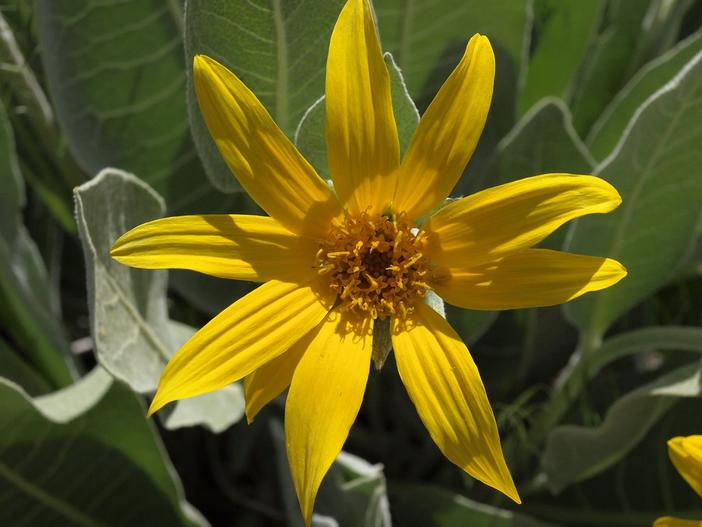Woolly Mule’s Ears
(Wyethia mollis)
Woolly Mule’s Ears (Wyethia mollis)
/
/

Jim Morefield
CC BY-SA 2.0
Image By:
Jim Morefield
Recorded By:
Copyright:
CC BY-SA 2.0
Copyright Notice:
Photo by: Jim Morefield | License Type: CC BY-SA 2.0 | License URL: https://creativecommons.org/licenses/by-sa/2.0/ | Uploader: Jim Morefield | Publisher: Flickr






















Estimated Native Range
Summary
Wyethia mollis, commonly known as Woolly Mule’s Ears, is a perennial herb that is native to the mountainous regions of the western United States, specifically in northern California, southeastern Oregon, and western Nevada. It is typically found in open, dry meadows and sagebrush steppe ecosystems. The plant is well-adapted to these environments, often growing in volcanic soils. Woolly Mule’s Ears reach a height of up to 16 inches, occasionally growing taller, and are characterized by their lance-shaped leaves that are covered in dense, woolly hairs, giving them a silvery appearance.
The bright yellow ray florets of Woolly Mule’s Ears can be up to 2 inches long, blooming from late spring to early summer and attracting pollinators. The plant is valued for its showy flowers and its ability to thrive in poor, well-drained soils with minimal water once established, making it suitable for xeriscaping and native plant gardens. It is also used in restoration projects to stabilize soils. While the seeds are edible and likened to sunflower seeds, they are not commonly harvested for consumption. In cultivation, Woolly Mule’s Ears require full sun to part shade and are relatively low maintenance, but they can be susceptible to root rot if overwatered or planted in poorly drained soils.CC BY-SA 4.0
The bright yellow ray florets of Woolly Mule’s Ears can be up to 2 inches long, blooming from late spring to early summer and attracting pollinators. The plant is valued for its showy flowers and its ability to thrive in poor, well-drained soils with minimal water once established, making it suitable for xeriscaping and native plant gardens. It is also used in restoration projects to stabilize soils. While the seeds are edible and likened to sunflower seeds, they are not commonly harvested for consumption. In cultivation, Woolly Mule’s Ears require full sun to part shade and are relatively low maintenance, but they can be susceptible to root rot if overwatered or planted in poorly drained soils.CC BY-SA 4.0
Plant Description
- Plant Type: Herb
- Height: 2-2.5 feet
- Width: 2-3 feet
- Growth Rate: Slow, Moderate
- Flower Color: White, Yellow
- Flowering Season: Spring, Summer
- Leaf Retention: Deciduous, Semi-deciduous
Growth Requirements
- Sun: Full Sun, Part Shade
- Water: Low, Medium
- Drainage: Fast, Medium
Common Uses
Butterfly Garden, Deer Resistant, Drought Tolerant, Low Maintenance
Natural Habitat
Native to open, dry meadows and sagebrush steppe ecosystems, often in volcanic soils
Other Names
Common Names: Woolly Mule’s Ears, Great Northern Wyethia, Wooly Wyethia, Mule Ears
Scientific Names: , Wyethia mollis,
GBIF Accepted Name: